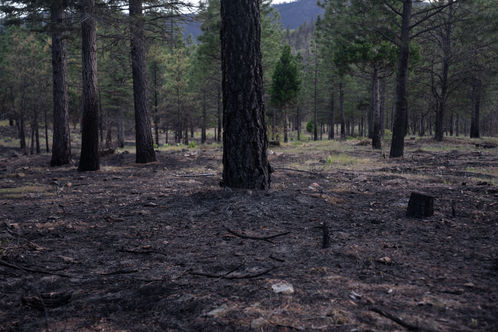
AIF crew 2024
Doug Tolman
Salt Lake City, UT
Doug Tolman is an interdisciplinary artist and place-learner practicing in Great Salt Lake and Colorado River Watersheds. He believes inquiry and dialectic are our strongest tools for solving the West’s socio-ecological problems. He is a recent graduate of the University of Utah MFA program where he received the Frankenthaler Climate Art Award, Global Change and Sustainability Center Fellowship, and College of Fine Arts Research Excellence Fellowship. Residing in the space between sculpture, image, and community work, his practice is informed by place-based youth education, ecological science, and biomechanical travel. The materials and imagery he works with come from burn scars, floodplains, lakebeds, and lava flows, places where geologic and anthropogenic time are in constant dialogue. His collecting process is rooted in generational rock hounding, map reading, and wood carving, which he now employs to deepen and reflect on a complex relationship with the land he calls home. By facilitating generative spaces of inquiry, he attempts to deepen his community’s sense of place in pursuit of solutions to climate and land-use challenges.
Doug's TREX reflection
Good Fire On The Ground
As I sit down to write this reflection in Salt Lake City, wildfire season in my bioregion is in full swing. A fast-running grass fire just happened in the foothills above my house, while big old-growth wildfires are smoldering out in the ranges above both my parents’ and grandmother’s homes in Southern Utah.
After 40 hours of asynchronous safety training this past spring, my time as an Artist-in-Fire began as I crossed the Great Basin in my rickety old truck. The basins and ranges passed like waves as I made my way west, Elko, Pyramid Lake, Reno, and finally Plumas County, California to participate in a regional Prescribed Fire Training Exchange (TREX). Before this experience, I’d had minimal direct fire experience - most of my fire knowledge was obtained from stories of my dad’s experience in wildfire suppression, watching smoke columns rise from neighboring mountains, cauterizing wood surfaces with a torch, and exploring burn scars.

photo credit: Jade Elhardt
The event, Plumas CalTREX was hosted by The Watershed Research & Training Center and Plumas Underburn Cooperative. We were stationed at a summer camp within the scar of the 2021 Dixie Fire. It was a somber background to show up to - nearby Greenville was still in the process of rebuilding. The nerves of being a newcomer to both fire and place settled quickly as I learned how genuine and welcoming this community is; expectations of macho fire culture were quickly dispelled.
We were split into crews, following a rigid chain of command which somehow felt non-hierarchical despite the top-down structure. Each day was spent in workshops and drills leading up to a prescribed burn on the property during our final day. Drip torch drills were balanced out by a workshop on cultural burning with Danny YellowFeather Manning. Long, hard hours of digging line were softened by fire art therapy with Zach Browning of the Sierra Institute. Given the setting, structure, and community, it was essentially six days of prescribed fire summer camp.
On the final day, everyone gathered to put good fire on the ground. It was very reminiscent of a metal pour - anticipation built as we accepted position assignments, working together toward a common goal as smoke soaked into our fire-resistant clothing. I spent most of my time on holding, using hoses and hand tools to follow and care for the fire as it crept along the property. It felt good to steward the fire as it moved itself along, a living being breathing oxygen and eating carbon.
I’m now back home working on an ArcGIS story map that involves prescribed burning of invasive Phragmites weeds here at Great Salt Lake Shorelands Preserve, and spending time building Beaver Dam Analogues with Sageland Collaborative - something I see as very adjacent to prescribed burning (Beavers after all were taken from the West around the same time as good fire, the lower water table and channelized streams left behind are closely associated with increased fire danger). Though nothing concretely in the realm of art has propagated, the impacts of seeing good fire on the ground have trickled into my everyday life and work, the line of inquiry is continuing to grow and integrate. By the time an opportunity opens, hopefully this line of inquiry has developed into a place for an installation piece.
My Final Takeaways:
-
Buffer the corner, corners are where most problems happen.
-
Fire is a life form that breathes oxygen and eats carbon.
-
Oaks are prized and cared for in the Sierra, but are seen as ubiquitous in the Wasatch.
-
Land tells what it needs, spend the time to listen.
-Doug Tolman, summer 2024





